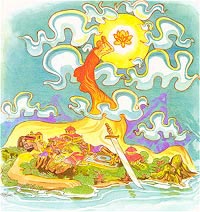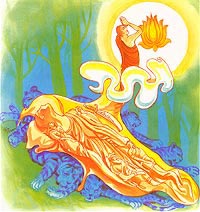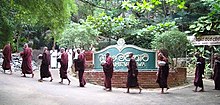through
http://sarvajan.ambedkar.org
sabbe satta bhavantu sukhi-tatta
TIPITAKA
TIPITAKA AND TWELVE DIVISIONS
Brief historical background
Sutta Pitaka
Vinaya Pitaka
Abhidhamma Pitaka
Twelve Divisions of Buddhist Canons
Nine Divisions of Buddhist Canons
Sutta Piṭaka
— The basket of discourses —Mahāsatipaṭṭhāna Sutta (DN 22) {excerpt} - all infobubbles— Attendance on awareness —Kāyānupassanā
IV. சட்டத்துக்கு அடிப்படையான அற முறைகளின் கூர்ந்த கவனிப்பு
E2. Samudayasacca சமுதயசத்தியத்தை விளக்கிக்காட்டுதல்
Dhammapada Verses 294 and 295 Lakundaka Bhaddiya Vatthu-Verse 294. The Destroyer Who Reaches NibbanaVerse 295. The ‘Killer’ Who Goes Free
ABOUT AWAKEN ONES WITH AWARENESS Canada
British Columbia
Monastère Bouddhiste de Tam Bao Son, Canton d’Harrington, Laurentides, Québec
• International Buddhist Temple, Richmond
• Ling Yen Mountain Temple
Nova Scotia
• Gampo Abbey
Ontario
• Mahamevnawa Buddhist Monastery (Theravada)
• Toronto Zen Centre
• Zen Centre of Ottawa
Quebec
• Montreal Zen Center
This sutta is widely considered as a the main reference for meditation practice.
| E2. Samudayasacca Niddesa
Katamaṃ ca, bhikkhave, dukkha·samudayaṃ ariya·saccaṃ? Y·āyaṃ taṇhā ponobbhavikā nandi·rāga·sahagatā tatra·tatr·ābhinandinī, seyyathidaṃ: kāma-taṇhā, bhava-taṇhā, vibhava-taṇhā. Sā kho pan·esā, bhikkhave, taṇhā kattha uppajjamānā uppajjati, kattha nivisamānā nivisati? Yaṃ loke piya·rūpaṃ sāta·rūpaṃ etthesā taṇhā uppajjamānā uppajjati, ettha nivisamānā nivisati. |
E2. Exposition of Samudayasacca
And what, bhikkhus, is the dukkha-samudaya ariyasacca? It is this taṇhā leading to rebirth, connected with desire and enjoyment, finding delight here or there, that is to say: kāma-taṇhā, bhava-taṇhā and vibhava-taṇhā. But this taṇhā, தமிழ் மற்றும் எது, பிக்குளே, dukkha-samudaya ariyasacca துக்கத்தின் மூலக்காரணமான மேதக்க மெய்ம்மை ? அது இந்த, மறுபிறப்பிற்கு வழிகாட்டும் அடக்க முடியாத ஆசை/இச்சை/தாகம்/தகாச் சிற்றின்பவேட்கை, அத்துடன் இணைக்கப்பட்ட ஆர்வ வேட்கை மற்றும் இன்பம் நுகர்தல், இங்கும் அங்குமாக களிப்பூட்டு காண்டல், அதை வாக்காட: kāma-taṇhā, bhava-taṇhā and vibhava-taṇhā புலனுணர்வுக்கு ஆட்பட்ட சபல இச்சை, மறுமுறை தொடர்ந்து உயிர் வாழ அடக்க முடியாத ஆசை மற்றும் மறுமுறை தொடர்ந்து உயிர் வாழாதிருக்க அடக்க முடியாத ஆசை. ஆனால் இந்த taṇhā அடக்க முடியாத ஆசை/இச்சை/தாகம்/தகாச் சிற்றின்பவேட்கை, பிக்குளே, எழும்பும் நேரத்தில், அது எங்கே யெழும்புகிறது, தானே நிலைகொள்கிற நேரத்தில், அது எங்கே நிலைகொள்கிறது? அங்கே இந்த உலகத்தினுள்ளே எவை மகிழ்வளிக்கிற மற்றும் ஒத்துக்கொள்கிறதாகக் காணப்படுகிற , அங்கே தான் taṇhā அடக்க முடியாத ஆசை/இச்சை/தாகம்/தகாச் சிற்றின்பவேட்கை, எழும்பும் நேரத்தில், அது எங்கே யெழும்புகிறது, தானே நிலைகொள்கிற நேரத்தில், அது எங்கே நிலைகொள்கிறது. |
|
Kiñca loke piya·rūpaṃ sāta·rūpaṃ? Cakkhu loke piya·rūpaṃ sāta·rūpaṃ etthesā taṇhā uppajjamānā uppajjati, ettha nivisamānā nivisati. Sotaṃ loke piya·rūpaṃ sāta·rūpaṃ etthesā taṇhā uppajjamānā uppajjati, ettha nivisamānā nivisati. Ghānaṃ loke piya·rūpaṃ sāta·rūpaṃ etthesā taṇhā uppajjamānā uppajjati, ettha nivisamānā nivisati. Jivhā loke piya·rūpaṃ sāta·rūpaṃ etthesā taṇhā uppajjamānā uppajjati, ettha nivisamānā nivisati. Kayo loke piya·rūpaṃ sāta·rūpaṃ etthesā taṇhā uppajjamānā uppajjati, ettha nivisamānā nivisati. Mano loke piya·rūpaṃ sāta·rūpaṃ etthesā taṇhā uppajjamānā uppajjati, ettha nivisamānā nivisati. |
And what in the world is pleasant and agreeable? The eye in the world is pleasant and agreeable, there taṇhā, when arising, arises, there when settling, it settles. The ear in the world is pleasant and agreeable, there taṇhā, when arising, arises, there when settling, it settles. The nose in the world is pleasant and agreeable, there taṇhā, when arising, arises, there when settling, it settles. The tongue in the world is pleasant and agreeable, there taṇhā, when arising, arises, there when settling, it settles. Kāya in the world is pleasant and agreeable, there taṇhā, when arising, arises, there when settling, it settles. Mana in the world is pleasant and agreeable, there taṇhā, when arising, arises, there when settling, it settles. மற்றும் எது இந்த உலகத்தினுள்ளே எவை மகிழ்வளிக்கிற மற்றும் ஒத்துக்கொள்கிறதாகக் காணப்படுகிறது? இந்த கண்கள் உலகத்தினுள்ளே மகிழ்வளிக்கிற மற்றும் ஒத்துக்கொள்கிறதாகக் காணப்படுகிறது, அங்கே தான் taṇhā அடக்க முடியாத ஆசை/இச்சை/தாகம்/தகாச் சிற்றின்பவேட்கை, எழும்பும் நேரத்தில், அது எங்கே யெழும்புகிறது, தானே நிலைகொள்கிற நேரத்தில், அது எங்கே நிலைகொள்கிறது. இந்த காது உலகத்தினுள்ளே மகிழ்வளிக்கிற மற்றும் ஒத்துக்கொள்கிறதாகக் காணப்படுகிறது, அங்கே தான் taṇhā அடக்க முடியாத ஆசை/இச்சை/தாகம்/தகாச் சிற்றின்பவேட்கை, எழும்பும் நேரத்தில், அது எங்கே யெழும்புகிறது, தானே நிலைகொள்கிற நேரத்தில், அது எங்கே நிலைகொள்கிறது. இந்த மூக்கு உலகத்தினுள்ளே மகிழ்வளிக்கிற மற்றும் ஒத்துக்கொள்கிறதாகக் காணப்படுகிறது, அங்கே தான் taṇhā அடக்க முடியாத ஆசை/இச்சை/தாகம்/தகாச் சிற்றின்பவேட்கை, எழும்பும் நேரத்தில், அது எங்கே யெழும்புகிறது, தானே நிலைகொள்கிற நேரத்தில், அது எங்கே நிலைகொள்கிறது. இந்த நாக்கு உலகத்தினுள்ளே மகிழ்வளிக்கிற மற்றும் ஒத்துக்கொள்கிறதாகக் காணப்படுகிறது, அங்கே தான் taṇhā அடக்க முடியாத ஆசை/இச்சை/தாகம்/தகாச் சிற்றின்பவேட்கை, எழும்பும் நேரத்தில், அது எங்கே யெழும்புகிறது, தானே நிலைகொள்கிற நேரத்தில், அது எங்கே நிலைகொள்கிறது. இந்த Kāya காயம் உடல் உலகத்தினுள்ளே மகிழ்வளிக்கிற மற்றும் ஒத்துக்கொள்கிறதாகக் காணப்படுகிறது, அங்கே தான் taṇhā அடக்க முடியாத ஆசை/இச்சை/தாகம்/தகாச் சிற்றின்பவேட்கை, எழும்பும் நேரத்தில், அது எங்கே யெழும்புகிறது, தானே நிலைகொள்கிற நேரத்தில், அது எங்கே நிலைகொள்கிறது. இந்த Mana மனம் உலகத்தினுள்ளே மகிழ்வளிக்கிற மற்றும் ஒத்துக்கொள்கிறதாகக் காணப்படுகிறது, அங்கே தான் taṇhā அடக்க முடியாத ஆசை/இச்சை/தாகம்/தகாச் சிற்றின்பவேட்கை, எழும்பும் நேரத்தில், அது எங்கே யெழும்புகிறது, தானே நிலைகொள்கிற நேரத்தில், அது எங்கே நிலைகொள்கிறது. |

TO







 |
Verse 294. The Destroyer Who Reaches Nibbana
Explanation: The brahmin kills the mother - craving, kills |
 |
Verse 295. The ‘Killer’ Who Goes Free
Explanation: The brahmin (arahat) kills the mother - craving; |
Dhammapada Verses 294 and 295
Lakundaka Bhaddiya VatthuMataram pitaram hantva
rajano dye ca khattiye
rattham sanucaram hantva
anigho yati1 brahmano.Mataram pitaram hantva
rajano dve ca sotthiye
veyagghapancamam2 hantva
anigho yati brahmano.Verse 294: Having killed mother (i.e., Craving), father (i.e., Conceit), and
the two kings (i.e., Eternity-belief and Annihilation-belief), and having
destroyed the kingdom (i.e., the sense bases and sense objects) together with
its revenue officer (i.e., attachment), the brahmana (i.e., the arahat) goes
free from dukkha.Verse 295: Having killed mother, father, the two brahmin kings and having
destroyed the hindrances of which the fifth (i.e., doubt) is like a
tiger-infested journey, the brahmana (i.e., the arahat) goes free from dukkha.
1. anigho yati: goes unharmed, i.e., liberated from the round of rebirths
(samsara).2. veyagghapancamam: veyaggha + pancamam, i.e., like a tiger + the fifth.
There are five hindrances, nivaranas. The reference here is to the fifth
hindrance, viz., doubt (vicikiccha).
The Story of Thera Bhaddiya, the Short One
While residing at the Jetavana monastery, the Buddha uttered Verses (294) and
(295) of this book, with reference to Thera Bhaddiya who was also known as
Lakundaka Bhaddiya because of his short stature.On one occasion, some bhikkhus came to visit and pay homage to the Buddha at
the Jetavana monastery. While they were with the Buddha, Lakundaka Bhaddiya
happened to pass by not far from them. The Buddha called their attention to the
short thera and said to them, “Bhikkhus, look at that thera. He has
killed both his father and his mother, and having killed his parents he goes
about without any dukkha.” The bhikkhus could not understand the
statement made by the Buddha. So, they entreated the Buddha to make it clear to
them and the Buddha explained the meaning to them.In the above statement, the Buddha was referring to an arahat, who had
eradicated craving, conceit, wrong beliefs, and attachment to sense bases and
sense objects. The Buddha had made the statement by means of metaphors. Thus,
the terms ‘mother’ and ‘father’ are used to indicate craving and conceit
respectively. The Eternity-belief (Sassataditthi) and Annihilation-belief
(Ucchedaditthi) are likened to two kings, attachment is likened to a revenue
officer and the sense bases and sense objects (the ajjhatta and bahiddha
ayatanas) are likened to a kingdom.After explaining the meaning to them, the Buddha spoke in
verse as follows:
Verse 294: Having killed mother (i.e., Craving),
father (i.e., Conceit), and the two kings (i.e., Eternity-belief and
Annihilation-belief), and having destroyed the kingdom (i.e., the
sense bases and sense objects) together with its revenue officer
(i.e., attachment), the brahmana (i.e., the arahat) goes free from
dukkha.Verse 295: Having killed mother, father, the two
brahmin kings and having destroyed the hindrances of which the fifth
(i.e., doubt) is like a tiger-infested journey, the brahmana (i.e.,
the arahat) goes free from dukkha.
At the end of the discourse the visiting bhikkhus attained arahatship.
Canada
British Columbia
Monastère Bouddhiste de Tam Bao Son, Canton d’Harrington, Laurentides, Québec
• International Buddhist Temple, Richmond
http://en.wikipedia.org/wiki/International_Buddhist_Temple
The International Buddhist Temple (also 觀音寺 in Chinese; Guan Yin Sì in pinyin; Guan Yin Temple) is located in Richmond, British Columbia, Canada. It is a Chinese Buddhist temple run by the International Buddhist Society.
While the Society officially practices Mahayana Buddhism, the temple is open to Theravada Buddhist affiliates and visitors, as well as visitors of all religious and cultural backgrounds.
Contents |
History
In 1979, two Buddhists from Hong Kong
donated land and funds to the cause of building an authentic Chinese
Buddhist temple in North America. The International Buddhist Society was
established in 1981 for this cause by the Venerable Guan Cheng and five
other individuals. The International Buddhist Temple officially opened
to the public after two years, when its Main Hall was completed.
Thousands of people, including Richmond’s mayor and Member of Parliament, attended the inauguration ceremony in 1986.
International Buddhist Society
The International Buddhist Society is a non-profit organization and a
registered Canadian charity. It sponsors charitable programs both in
Canada and abroad. Some of the Society’s efforts include:
- Donations to the Food Bank
- Rescuing and releasing sealife and other creatures
- Support for the poor and disadvantaged in rural China
- Aid for students and the elderly
The Society also hosts free events for the community, such as
Senior’s Day celebrations with free vegetarian lunches for seniors at
the temple.
The Venerable Guan Cheng
The Venerable Guan Cheng has been the head of the Society and the
temple’s Abbot since 1999. A student of Buddhism for more than 40 years,
he was ordained in 1999 by the Venerable Master Xu Lang, at the Miao Fa Monastery in the US.
The abbot speaks Cantonese, English, and Mandarin, and has a B.A. and M.B.A. from the University of Toronto. He was one of two delegates for Canada at the First World Buddhist Forum in China. He travels widely to spread Buddhist teachings and perform charity work, and holds frequent lectures and classes.
He hosts a radio show on AM1320 (Overseas Chinese Voice) in Vancouver, and Metroshowbiz FM99.7 in Hong Kong. He is also a columnist for Hong Kong’s Buddhist Compassion Magazine.
The Venerable Guan Cheng has written and published: Happiness Originates from the Mind (2003), How to Attain Happiness by Appeasing One’s Mind (2004), Prajna-Paramita Hirdya Sutra Commentary (2006), and A Bouquet of Incense from the Heart (2006).
Architecture
The temple is the most authentic structure of traditional Chinese palatial style in North America.[citation needed] Its design is based on the Forbidden City in Beijing, China. The International Buddhist Temple features golden tiles on its two-tiered roof, flared eaves, and two scholar’s courtyards. Beyond the main courtyard is the classical Chinese garden with lotus ponds, twin gazebos,
rock landscapes, and a stone bridge. One attraction is the flowing
Wisdom Fountain at the edge of the pond. Worshippers believe that water
from the Wisdom Fountain has cleansing properties and other benefits.
There is also the Siddhartha Gautama Pool, in which nine white dragons
spout water towards the sky. They represent the nine heavenly dragons
which bathed Prince Siddhartha Gautama as a newborn.
At the centre of the temple is the Main Gracious Hall. Beneath its
Northern imperial Chinese exterior of gold and red is a Western
structural frame of concrete and steel. It houses five great Buddha and Bodhisattva statues. The statue of Buddha Sakyamuni is the largest in North America.[citation needed] The building contains a gift shop.
Across from the Main Hall in the Worshipping Square is the Seven Buddha Pavilion. Within it are the Four Heavenly Kings and the Avalokitesvara Buddha, or Guan-Yin, with a thousand hands and eyes.
There are also a Thousand Buddha Hall, Ksitigarbha
(Ancestral) Hall, and Meditation Hall, as well as many smaller shrines
on the grounds. As of 2007, the temple is still undergoing expansions.
Art
From 1986 to 1991, the Society held a monthly Chinese art exhibition, Karma of the Brush. All artists in the Greater Vancouver
area were welcome to share their works with the public. Out of this
arose the Seven Buddha Mural, painted by one of the artists and founders
of the exhibition, Fung Kai Mun. It took two years to complete, and is currently the largest Buddhist mural in the world.[citation needed]
The wall facing the garden displays the Amitabha Buddha mural. It is engraved with the Buddha’s name as a reminder of the Mahayana goal of rebirth into the Amitabha Buddha’s Pure Land.
The Venerable Guan Cheng has an interest in gardening and landscape.
All of the flower arrangements around the temple, as well as the garden,
are designed by the abbot with both Chinese tradition and Buddhist
aesthetics in mind. There are also bonsai, and Buddhist idioms carved in stone.
The entrance of the International Buddhist Temple is inspired by Deer Park,
with its gentle slopes, trees, and artificial deer. Deer Park was where
the Buddha Sakyamuni gave his first sermons to his followers. There are
also several other Buddhist stories and historical events tied to the
place.
Programs and Services
The International Buddhist Society hosts English-language meditation
classes every Saturday beginning at 9 a.m. and the temple periodically
hosts retreats. Venerable Guan Cheng himself conducts lectures and
Dharma Talks regularly in English, Cantonese, and Mandarin. He discusses everything from practical applications of Buddhist wisdom to ancient scriptures in Sanskrit.
The abbot’s Dharma Talks are available on DVD and the IBS website[1], and electronic copies of his published books can be read online.
Visitors may honour the Buddhas and Bodhisattvas by making
contributions to the temple. Avalokitesvara, for example, is the
embodiment of Compassion, and helps individuals overcome troubles and
acquire health and happiness. General Guan represents loyalty and
righteousness. Contributions to him will bring protection from harm,
illness, and evil.
The temple offers guided tours for groups of 15 or more. The Sangha holds daily prayer sessions and special ceremonies in the Main Gracious Hall.
• Ling Yen Mountain Temple
http://en.wikipedia.org/wiki/Ling_Yen_Mountain_Temple
|
|
This article needs additional citations for verification. (February 2011) |
The Ling Yen Mountain Temple (Chinese: 靈巖山寺; pinyin: líng yán shān sì) in Richmond, British Columbia, Canada is a Buddhist monastery, designed by Pacific Rim Architecture in the Chinese palatial style and completed in 1996.[1] The temple has about 10,000 members in Greater Vancouver and several dozen resident monastics.
Contents
- 1 Tradition
- 2 Location
- 3 Plans for expansion
- 4 Celebrations
- 5 Notes
- 6 Further reading
- 7 External links
Nova Scotia
• Gampo Abbey
http://en.wikipedia.org/wiki/Gampo_Abbey
| Part of a series on |
| Buddhism |
|---|
 |
Gampo Abbey is a Buddhist abbey located in Pleasant Bay, Nova Scotia.
It was founded by Chögyam Trungpa Rinpoche in 1984 as a centre of North American Buddhism in the Vajrayana tradition of the Karma Kagyu school of Tibetan Buddhism. The Abbey is associated with the Vajradhatu Buddhist Church of Canada and Shambhala International. Khenchen Thrangu Rinpoche now serves as abbot.
Gampo Abbey’s resident teacher is the well-known Buddhist nun and teacher Pema Chödrön. There are twelve monks and nuns at the abbey as of March 2009, a small number of whom are bhikṣus, with four more expected by May 2009.[1] All are ordained in the Mulasarvastivadin lineages of vinaya, or in the case of the bhikṣuṇīs, a combination of the Mulasarvastivadin and Dharmaguptaka lineages.
On August 26, 2001, Nova Scotia’s first stupa was consecrated at Gampo Abbey. It is a Stupa of Enlightenment dedicated to world peace, and contains relics of the abbey’s founder Vidyadhara Chögyam Trungpa Rinpoche.
Ontario
• Mahamevnawa Buddhist Monastery (Theravada)
http://en.wikipedia.org/wiki/Mahamevnawa_Buddhist_Monastery
| This article relies on references to primary sources or sources affiliated with the subject. (May 2011) |
| Mahamevnawa Buddhist Monastery | |
|---|---|
| Motto | The world that Buddha saw |
| Formation | 14 August 1999 |
| Type | Organization of Buddhist monasteries |
| Purpose/focus | Spiritual Development |
| Headquarters | Polgahawela, Sri Lanka |
| Location | Sri Lanka (35 branches); Toronto, CA; New Jersey, USA; Sydney, AU; London, UK; Offenbach, DE (List of Mahamevnawa Branches) |
| Region served | Worldwide |
| Membership | practicing Buddhists |
| Founder | Kiribathgoda Gnanananda Thero |
| Website | http://www.mahamevnawa.lk http://www.buddhavision.com |
Mahamevnawa Buddhist Monastery is an organization of Buddhist monasteries, of Sri Lankan origin established to benefit the spiritual development of human beings using the teachings of the Gautama Buddha.[1] Its main main monastery is in Polgahawela, Sri Lanka, and Sri Lanka is home to 35 branches of the organization. Overseas branches are in Canada,[2] USA, Australia, UK [3] and Germany.[4]
The founder and the chief Buddhist monk in charge of these monasteries is Venerable Kiribathgoda Gnanananda Thero,
who is engaged in spreading Buddhism to both local and international
communities, and in highlighting the aim of Buddhism: putting and end to
Dukkha (suffering) or attaining Nibbana.
Contents |
Practicing Dhamma
Mahamevnawa monasteries promote teaching, discussion and practice of
Dhamma in unaltered form, and that the first step towards cession of
suffering is getting to know Buddha’s teaching. Mahamevnawa also
facilitates the practice of meditation, one of the key tools for
improving concentration and wisdom, through cultivating mindfulness (Sathi)
as a component of the path to Nibbāna. A key point that Mahmevnawa
highlights is that Dhamma not only says that life is suffering, but also
shows a proven path to cession of that suffering.
Spreading Dhamma
Both lay and clergy associated with Mahamevnawa adhere to this
whenever possible. The way of preaching and teaching Dhamma adopted by
the clergy at Mahamevnawa is what Buddha advocated.[citation needed]

Mahamevnawa Sadaham Prakashana (Mahamevnawa Dhamma Publications) [1]
• Toronto Zen Centre
http://en.wikipedia.org/wiki/Toronto_Zen_Centre
| Toronto Zen Center | |
|---|---|
 |
|
| Information | |
| Denomination | Sanbo Kyodan |
| Founded | 1972 |
| Founder(s) | Philip Kapleau |
| Abbot(s) | Sensei Taigen Henderson |
| Priest(s) | Sensei Sunyana Graef |
| Address | 33 High Park Gardens, Toronto, Ontario M6R 1S8 |
| Country | Canada |
| Website | http://www.torontozen.org |
The Toronto Zen Center (or, Toronto Zen Center), is a Sanbo Kyodan Zen Buddhist practice center in Toronto, Ontario. It is modeled after the Rochester Zen Center. They offer introductory workshops in Zen Buddhism. The Toronto Zen Centre offers a couple of unique Buddhist course in Loving Kindness Meditation and periodically offers Mastering Breath Awareness or an MBA.
Contents
• Zen Centre of Ottawa
http://en.wikipedia.org/wiki/Zen_Centre_of_Ottawa
Coordinates: 45.4289°N 75.6818°W The White Wind Zen Community (WWZC) is a Sōtō Zen Buddhist association based at the Zen Centre of Ottawa (Honzan Dainen-ji) in Ottawa, Ontario, with branch centres in Wolfville, Nova Scotia and Harrow, England. The Community is led by the Venerable Anzan Hoshin roshi.
It consists of both a monastic order, the Northern Mountain Order, and a
large community of associate, general, and formal lay students.
The WWZC was founded in 1985 as the White Wind Zazenkai (Hakukaze Zazenkai),
named after the Hakukaze-ji monastery of Anzan Hoshin roshi’s teacher,
the late Ven. Yasuda Joshu Dainen Hakukaze. The association was renamed
“White Wind Zen Community” in 1989. While Anzan Hoshin roshi is still in
permanent residence at the Ottawa centre, he retired from public
teaching in 1991 and currently teaches only monastic and formal
students. Lay teaching is currently performed by his Dharma-successors,
the Ven. Shikai Zuiko osho and the Ven. Jinmyo Renge osho, and by
practice advisors trained by Anzan Hoshin roshi.
In addition to offering an intensive schedule of practice year-round, including sittings, sesshin
and outreach of a Western Zen centre, the WWZC provides a large number
of individual students outside of commuting distance of the monastery or
its branches with long-distance training. The long-distance training
program provides students practice interviews and daisan via e-mail, telephone, or letter, and grants students access to a library of over 2000 recorded dharma talks. The WWZC also publishes books and audio recordings through its publishing arm, Great Matter Publications.
Quebec
• Montreal Zen Center
http://en.wikipedia.org/wiki/Montreal_Zen_Center
| Montreal Zen Center | |
|---|---|
 |
|
| Information | |
| Denomination | Harada-Yasutani |
| Founded | 1975 |
| Abbot(s) | Albert Low |
| Address | 824 Park Stanley, Montréal, Québec H2C 1A2 |
| Country | Canada |
| Website | www.zenmontreal.ca/en/ |
Montreal Zen Center is a Sōtō/Rinzai Zen Buddhist sangha located in Montreal, Quebec, Canada in the Harada Tangen/Haku’un Yasutani line . The community offers for members only intensive Zen sesshin
retreats, of seven day, three day and two day duration. Introductory
workshops are given for the general public, with follow –up and training
programs for those wishing to become members. The Montreal Zen Centre
was initially established in Montreal in 1975 as an affiliate of the Rochester Zen Center. The Center moved to its current location in 1979. Since 1979 the teacher at the Montreal Zen Center has been Albert Low, who received full transmission from Philip Kapleau in 1986 and became a teacher in his own right. The Centre became fully autonomous in 1986 with Dr. Albert Low
as the teacher and director. The Montreal Zen Center currently has over
200 members. The members are directly involved in running the Center.
THE STOLEN PLOW
[65]
| A |
T one time there were two traders who were great friends.
One of them lived in a small village,
and one lived in a large town near-by.
One day the village trader took his plow
to the large town to have it mended.
Then he left it with the trader who lived there.
After some time the town trader sold the plow, and kept the money.
When the trader from the village came to get his plow
the town trader said, “The mice have eaten your plow.”
“That is strange! How could mice eat such a thing?”
said the village trader.
That afternoon when all the children went down
to the river to go swimming,
the village trader took the town trader’s little son
to the house of a friend saying,
“Please keep this little boy here until I come back for him.”
By and by the villager went back to the town trader’s house.
“Where is my son? He went away with you.
Why
didn’t
you bring him back?” asked the town trader.
[66] “I took him with me and left him on the bank of that river
while I went down into the water,” said the villager.
“While I was swimming about a big bird seized your son,
and flew up into the air with him.
I shouted, but I could not make the bird let go,” he said.
“That cannot be true,” cried the town trader.
“No bird could carry off a boy. I will go to the court,
and you will have to go there, and tell the judge.”
The villager said, “As you please”;
and they both went to the court. The town trader said to the judge:
“This fellow took my son with him to the river,
and when I asked where the boy was, he said
that a bird had carried him off.”
![[Illustration]](http://www.mainlesson.com/books/babbitt/morejataka/zpage067.gif)
“What have you to say?” said the judge to the village trader.
“I told the father that I took the boy with me,
and that a bird had carried him off,” said the village trader.
“But where in the world are there birds strong enough
to carry off boys?” said the judge.
“I have a question to ask you,” answered the village trader.
“If birds cannot carry off boys, can mice eat plows?”
“What do you mean by that?” asked the judge.
“I left my good plow with this man.
When I came for
[67] it he told me that the mice had eaten it.
If mice eat plows, then birds carry off boys;
but if mice cannot do this, neither can birds carry off boys.
This man says the mice ate my plow.”
The judge said to the town trader,
“Give back the plow to this man, and he will give your son back to you.”
And the two traders went out of the court,
and by night-time one had his son back again,
and the other had his plow.
http://www.referenceforbusiness.com/business-plans/Business-Plans-Volume-03/Indoor-Playground.html

VOICE OF SARVAJAN




















